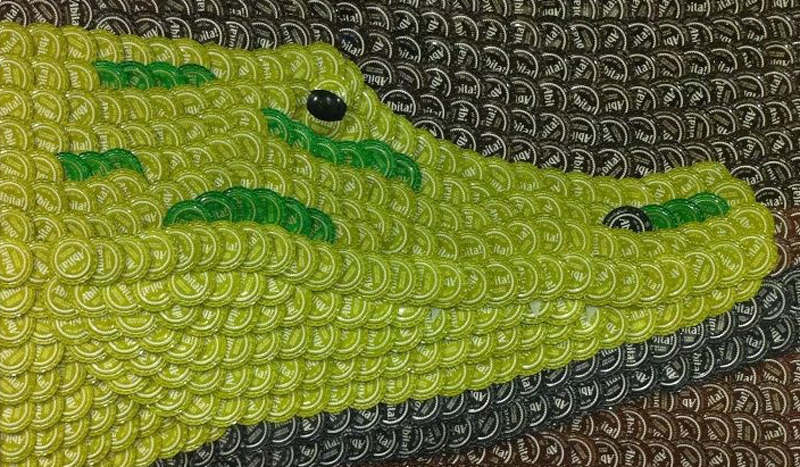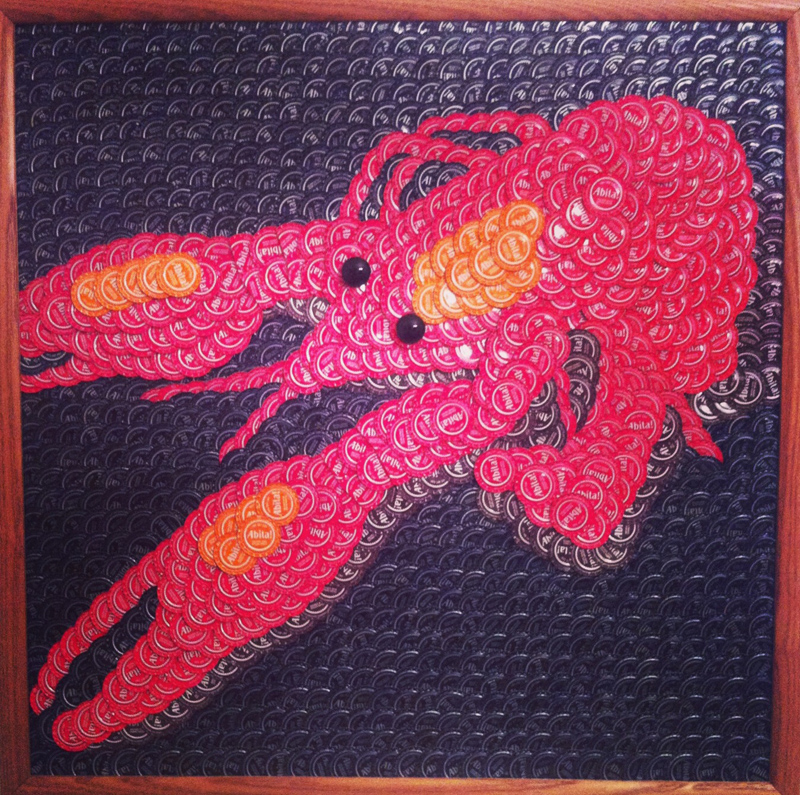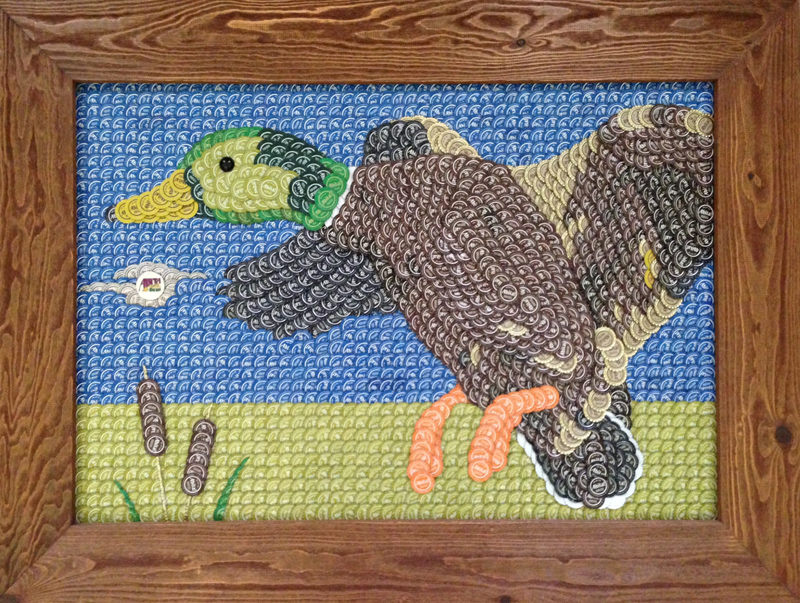How One Man Turned The Simple Bottle Cap Into Works of Art

A close-up look at one of Ian Vandenberg’s pieces of artwork, constructed from beer bottle caps. (Courtesy Ian Vandenberg)
If you tour the Abita Brewing Co. in Covington, LA, there is a piece of art to the right-hand side of the bar that stands out. It’s a pelican, that grand bird, standing in a pool of water looking out toward the horizon. It’s made entirely of bottle caps—1,800 to be exact. It’s the work of local artist Ian Vandenberg, and on a recent visit to the Bayou State, All About Beer Magazine was able to see his work up close and then engage him in a conversation about his stunning art in a nontraditional medium.
All About Beer: How did you get started working in bottle caps?
Ian Vandenberg: I was actually touring the Abita brewery about four years ago and saw a piece of bottle cap art there. The guy had just laid caps down side-by-side in the shape of the state of Louisiana. I had always collected beer bottle caps and almost exclusively drank Abita beer, so I thought I would give the bottle cap art thing a try. I have always been artistic, although more of a graphic artist by nature. I wanted to do something with my Abita caps and Louisiana-inspired, so I thought about doing a pelican. I started laying out caps and figured overlaying the caps would give the piece more detail, and the only way I could overlap them is to flatten them.
What’s the difference between using flattened and unflattened caps?
The problem, I guess you could say, with overlapping caps is you have to use a lot more than you would if you just put them side-by-side. So that state of Louisiana piece is really large (36 inches by 33 inches) but only has 350 caps. If I overlap caps, like the crawfish for example, that piece is only 24 inches by 24 inches but has about 1,200 caps.
Flattening caps sounds exhausting.
At first I just used a hammer to flatten them. I actually flattened all 1,800 caps for the pelican one at a time with a hammer on a metal plate. After that, I bought a small arbor press and was using that to flatten them, but still one at a time. Now I use a modified rolling press with some metal plates I had cut, and can flatten 6-10 at a time. Unused caps are the best, because the edges are already flared out. When I’m working with used caps that were taken off a bottle, I have to use needle-nose pliers to bend the edges out before I can flatten them. Another reason why the pelican took so long. I used mostly used caps that I had to bend the edges out prior to flattening them.
You’re talking about a lot of caps. You can’t possibly be drinking all this beer, so how are you sourcing caps?
I had a collection of caps from the start, but when I realized that I would need much more than that to make the pelican, I was asking friends to collect their Abita caps for me. I was also going around to local bars and restaurants and begging for caps. I remember going to an event that Abita sponsored, and going around to all the bar areas and collecting caps. I left that night with a couple hundred caps, I think. Then I emailed Kathy at Abita and asked if she could give me any caps. She ended up mailing me hundreds of them. She is why I do bottle cap art today and why I love Abita beer the way I do. It’s more than just a good beer. It’s the people that make it.
But I remember the weeks before I finished the pelican, I would run to the store and get beer and specifically get certain brews because I needed that color cap.
This is a side project for you right now, but do you hope to go full-time with bottle cap art?
My grand plan would be to one day truly do this for a living. I make some money now with my artwork, but I also work a 9-5 day job. My ultimate goal would be to do my artwork for a living and make enough money and stay busy enough to quit my day job. I’d love to have a small studio one day.
An average piece takes me usually two to three weeks to complete. I can do smaller pieces in just a few days if I need to meet a deadline, while some of my larger pieces that have no set deadline, I have spent a year on a single piece. But normally clients come to me with a set deadline, like a birthday or Christmas, and I get it done in time, as long as it’s within reason.
See more of Vandenberg’s art—Pelican Cap Works—on Facebook or contact him at [email protected]
John Holl is the editor of All About Beer Magazine. Contact him via Twitter @John_Holl or email.




Great looking stuff! How much is a framed Purple and gold outline of La?
Ian. Your story is very similar to mine. Had a wad of beer caps from years of saving them, especially Shiner Bock. Thinking one day, “How do I use all these dust collectors, and connect it with some of my oNE of my other passions, fly fishing. I started playing with words and came up with a “Shiner Brock Trout”
I started my flattening the cap as well, bot found that by over lapping them by bending the lip under with a pair of lineman pliers, I could fit them exactly the way they needed to fit. You’re absolutely spot on about thus being very labor intensive, as well as a labor of love. I’m partial to Abita Beer myself, and did a “Coon Ass Beer Bass” for my friend at the Evangaline Cafe here in Austin. Would love to send you a couple of pic of some of my work, and see if you have some costructive criticism.
BTW – love your work.
I saw your work on Pinterest I think it was. I am an admirer. I have tried my hand at this with limited success. Yours are awesome. I have mostly used un-flattened caps. I nail mine. What do you use to adhere the cap together? I think the duck is awesome! BTW I am from New Orleans and love Abita beer. Take care.
Great works of art! What do you find the easiest way to flatten the caps?